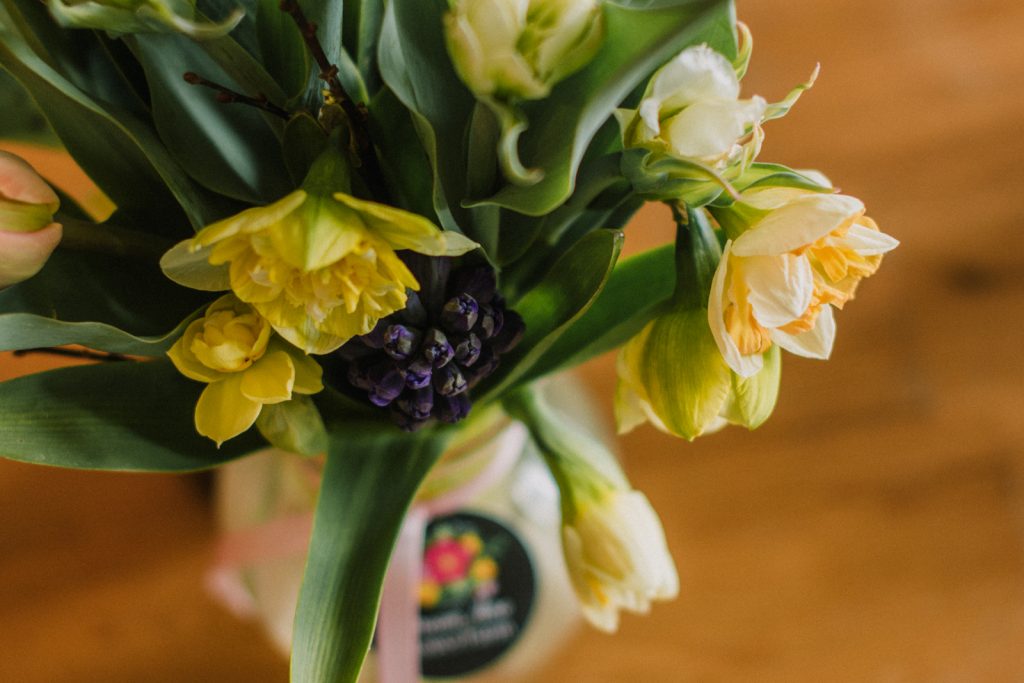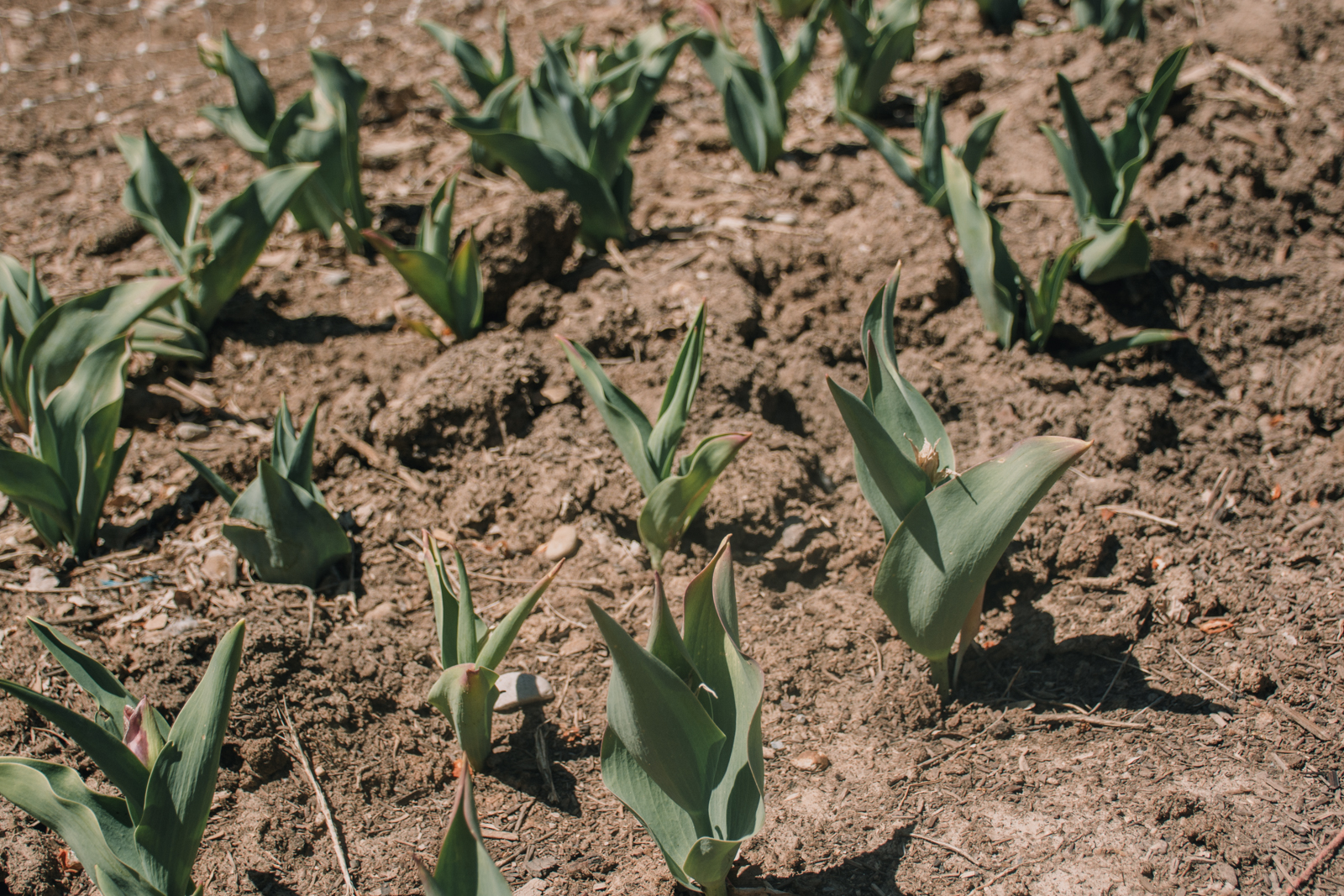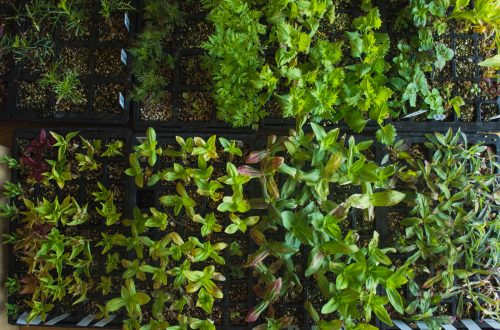
One of the most popular ways of making money from flower farming is by offering a CSA bouquet subscription. CSA stands for community-supported agriculture, and all it means is that your customer pays you upfront at the beginning of the season for a “cut” of your crop (in this case, flowers). The upfront payment provides some much-needed cash flow in the spring (when expenses are often the steepest), and while the consumer does take on some amount of risk, they also become invested in the profitability and well-being of the farm since they literally have basically become an investor in that year’s crop.

Types of CSA Bouquet Subscriptions
There are a few different strategies for offering CSA bouquet subscriptions.
- You can offer an all-season subscription, which means your customer will get a bouquet or arrangement usually weekly or every other week throughout the entirety of your season.
- You can offer a seasonal subscription, which means you might offer 5 bouquets in spring, 6 in summer, and 5 in fall for example. Customers can choose to purchase all three “seasons,” or they can pick and choose which season’s bouquets they want. Often, seasonal bouquets will be available on a weekly basis rather than every other week.
- You can offer monthly subscriptions, which is for just one bouquet per month throughout the season. On our farm, we call this the “mini all-season pass,” and it’s definitely one of our most popular options.
- Finally, you can do a kind of “punch pass” option, where people pay for a set number of bouquets (say, 4 or 6 or 8), and then they can choose which weeks that they “opt in” and receive one, depending on what flowers are in bloom.

Why Offer a CSA Subscription?
While offering CSA subscriptions comes with drawbacks (which we’ll cover in a minute), there are some enormous benefits to having a CSA subscription as part of your flower farm’s business model.
The first and probably biggest benefit is that it helps you to essentially “pre-sell” your flowers. DO NOT UNDERESTIMATE THIS. While it might seem when you’re first getting into flower farming that it will be insanely easy to sell your product just because it’s so beautiful, it’s not always as easy as you might think. There is nothing more discouraging than to spend hours harvesting and making up arrangements and bouquets, post them all to sell on social media (or go to your local farmer’s market), and then sell none, or just a small fraction of what you have available. And even if you ARE lucky enough to find buyers for them all (or most of them), you still have to set up pick up times, possibly drive all over to make deliveries, or do the opposite and stay put at your house for hours so people can come pick them up (many of whom will be late, I can almost guarantee it).
Selling CSA subscriptions basically eliminates a lot of that stress.
You know that the work you’re putting into bouquets has been compensated, and you know exactly who that arrangement will be going to. You can set up pickup and delivery times at your convenience at the beginning of the season, and you can streamline the process so you’re not having to be stuck at your house all day or glued to your phone waiting on correspondence.
The second benefit CSA subscriptions provide is that they give you a lot of your season’s cash flow right upfront. This makes it a lot easier to budget for those big springtime expansion expenses, or for you to set aside a big chunk to pay for your tulip order in the fall. I know for our farm, our income varies wildly from month to month, so getting a huge majority of our season’s income at the outset helps us to be able to budget more wisely for the whole year ahead.
Third, your CSA members will usually become your biggest fans because they are able to see your products over and over again, and they will often do the best job at spreading the word about your farm. I’ve even had several who regularly post pictures of all the arrangements they get from us to their social media, which is basically just free advertising every time they receive one.

Okay, So What are the Drawbacks?
Have I sold you on the idea of CSA subscriptions? Are you wanting to jump in immediately?
Not so fast.
While CSA subscriptions ARE my favorite way to make money on our flower farm, they come with some huge caveats.
First, you need to know you can provide flowers when you say you’ll have them.
This is the biggest thing, and the trickiest. If you’re offering a CSA subscription that goes from April to September (like we do), you need to have a concrete plan in place of exactly what flowers you’re going to have in bloom from April to September. The best way to do that is by having lots of data available at your fingertips from previous growing seasons. The second best way is to over-PLAN and over-PLANT so that you are basically trying to grow triple the amount you think you’ll actually need.
Second, you need to make sure you have backups for your first plan. Multiple backups.
In all my years of growing (both before as a home gardener and now as a flower farmer), I don’t think I’ve ever had a “normal” growing season. Every year comes with its hiccups, whether that’s hail that comes out and decimates half your blooms, a months-long drought and intense heat wave that kills everything but the toughest plants, or a pest infestation that comes in and destroys whole beds of flowers. Sometimes spring comes late, and your daffodils and tulips don’t come when expected. Sometimes you have frosts a whole month later than planned (or a month earlier).
The point is, you can plan and plant all you want, but you HAVE to have backups.
Firstly, you need to have backups on your own farm.
For example, I always plan for at least 3-4 focal flowers at any given time so that should I have multiple crop failures, at least one should come through for me.
Next, you need to have backups that are NOT on your own farm. This can take the form of generous family members, friends, or neighbors who are willing to let you cut their flowers (I always offer to pay, either in cash or in future flowers). It can also take the form of buying from other flower farmers in your area, or even from a wholesaler if you get really desperate.
Any way you look at it, you need to figure out what you’re going to do if your own stuff is either not ready in time, or if your crop didn’t come on at all.
Third, you need to figure out what you’ll do if catastrophe strikes and you’re unable to fulfill your side of the deal.
So, let’s say that you had a massive weather catastrophe wipe out 90% of your crop, or let’s say you invested in some bad compost, and it killed everything that you put in it.
What are you going to do if you know you will be entirely unable to fulfill your side of the bargain?
The answer will vary from flower farmer to flower farmer. Some say that the customer expects to take on some risk, and so they should know that flexibility is required. If it’s just a matter of perhaps delaying a bouquet for a week or two, I can maybe see that point, but in the end, you aren’t going to keep customers if you don’t deliver what you say you’re going to deliver. You need to decide ahead of the season if you’ll offer a full refund of any bouquets that were left undelivered, or if you’re going to try and source everything from outside places to make up the deficit.
Fourth, you need to price your subscriptions right so that you’re actually making money on them.
My first year offering subscriptions, I offered free delivery to almost everyone, with the exception of a few customers who lived a considerable distance away, whom I only charged a negligible fee per bouquet (we’re talking like $2.50 or $5 per bouquet for round trips that were more than an hour-long for me). While delivery might not be such a big deal if you’re delivering to someone who lives a few blocks away, or maybe to a pickup location you’ve coordinated at a local business, it can become a HUGE deal if you’re not factoring in your time and gas money if it’s starting to add up to more than a mile or two once or twice a week.
When I factored in all the time I spent making deliveries and all the gas money I shelled out (plus taking into account that I’d offered a bit of a discount on each individual bouquet with the more bouquets someone bought), there were some subscriptions I didn’t make any money on at all.
Although I lost some customers by charging for delivery the next year, I am now much more confident that I’m actually making money on my subscriptions, plus I literally gained back HOURS of my life every week.

How Do I Know If I’m Ready?
Let me share with you a story. MY story, to be precise.
Early in 2021, I decided to just jump in and go for my years-long dream of becoming a flower farmer. We finally had the land to do it, and because I am a die-hard researcher, I planned out every single detail down to the last square inch (or so I thought). Because I’d so carefully planned out my first season and had had some success growing cut flowers for myself before, I decided to just offer a CSA subscription my first year. It seemed like the easiest way to make money, and it also would be nice to have that chunk of money in the beginning when we were putting in so much new infrastructure.
Much to my surprise, I sold out of the limited number of subscriptions I was offering in about 24 hours thanks to a well-designed Facebook ad and supportive neighbors who jumped on right away. (This is totally crazy to me still, since we were literally untested, unproved, and virtually unknown in our new town. I could never thank those people enough who were willing to take such a big chance on our new farm!)
I did at least do some things right that first year. I limited the number of subscriptions to what I felt was a very “do-able” number, which was about 10 or so. I also had (I thought) carefully planned out the timing of everything so that I would have blooms throughout the season.
What actually happened was that for the first month of my subscription (May), I had almost zero blooms in my own garden other than some perennials that had been planted by the people who lived here before. Those perennials, however, were not enough to make up the bouquets I’d promised. Enter miracle #1, which is that through a friend of a family member, we were able to source all the cutting material we would need (for free) from a yard about two hours north of us because the owner had been a florist herself and had recently passed away. Her yard was filled with cutting material she’d often used herself, and her family members were about to raze the yard to get it ready to sell anyway (since it had become overgrown), and they let us take whatever we wanted first. Without all that, we never could have met any of our May subscriptions.
Then June came. I didn’t realize that in the flower farming world, June can actually be an extremely tricky month to have flowers because you’re between the spring-flowering bulbs and before all the summer crops. While some of my hardy annuals and experimentally-sowed early sunflowers did come through for me, I was only able to provide one bouquet to each CSA member, rather than the two I had promised. While I did make up the bouquet later in the season when we had an abundance, it was still embarrassing to not be able to pull through and deliver when we said we were going to.
July was still surprisingly sparse, and then August and September provided such a crazy abundance of flowers, we were unable to sell them all. Thankfully, those later bouquets in the season were so huge and so filled with blooms that they hopefully helped erase some of the very small, more pathetic arrangements from June and early July from our subscribers’ memories.
Honestly, I look back now and think I had to have been crazy to offer a subscription my first year flower farming. There was so much I didn’t know, and even just having one whole year’s worth of hard flower farming data would have helped out enormously in the years to come.
However, I’m also not sorry I just jumped in.
Jumping in with both feet forced me to see very, very quickly where I’d allowed for gaps, and it also forced me to find backups for future years (which came in handy again this year, when I once again had about a two-week gap in my own focal flowers and needed to rely on other people). Just going for it made me get a lot of important mistakes out of the way quickly so that when it came time to plan for this year, I knew what to do.
And this year’s CSA subscriptions have been about 1,000% less stressful than last year’s because I’d learned from my mistakes. I planted a lot more perennial focal flowers. I invested in a high tunnel structure. I made contacts with neighbors who I knew had an abundance of certain focal flowers just in case. I charged a fair price for delivery.
In the end, you’re probably not ever going to feel completely ready — there will always be unknown variables and things that come up that will cause you to be flexible. However, I *would* probably still recommend that you do at least have one full year’s worth of growing data under your belt (in which you’ve taken copious notes of exactly what was blooming when and how much) so that you can address those gaps BEFORE the next growing season begins.
Did that address all your questions? Anything else you’d like to know? Drop a comment below and let me know how I can help you!






